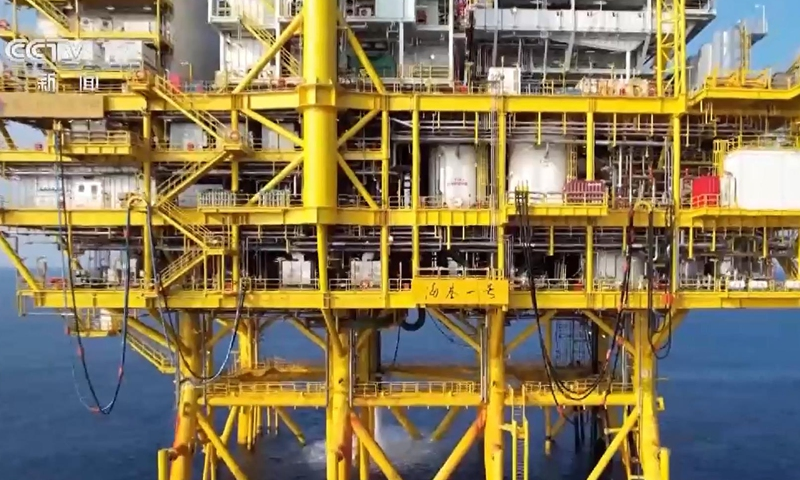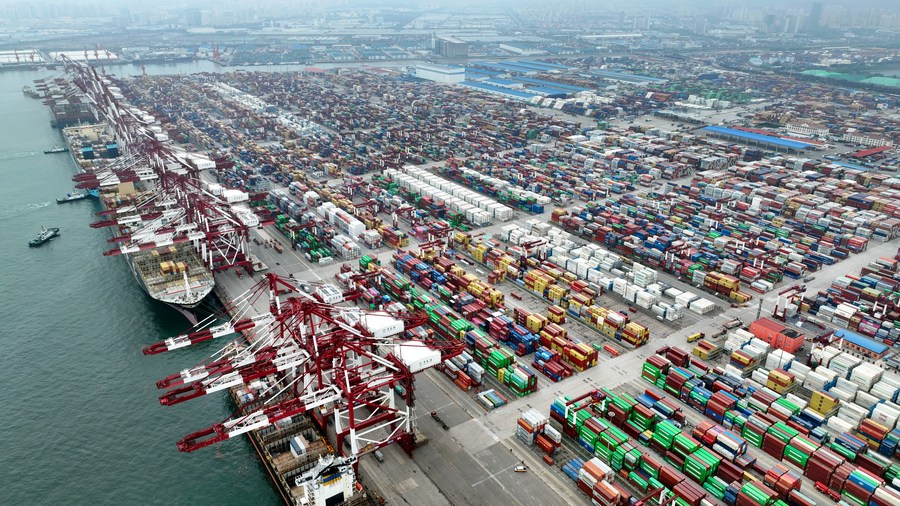1
Steps set for more stability in real estate

Ample room remains to maneuver the market into virtuous cycle, experts say
China's real estate sector is expected to be further stabilized in the coming months thanks to supportive policy measures, which will also help to shore up overall economic expansion, experts said on Monday.
They also said China still has ample policy room for maneuvering the real estate market into a virtuous cycle, following the recent announcement of several new measures to lower home purchase costs and boost rational demand.
These measures include refunding taxes for those who purchase residential properties within a year of selling previously owned residential assets, as well as lowering interest rates for housing provident fund loans for first-time homebuyers. Moreover, some cities will be eligible to loosen the lower limit for mortgage rates for first-time homebuyers.
"The Chinese authorities have stepped up support for the real estate market in recent days, and the moves in lockstep have introduced a strong buttress to the market from multiple dimensions, which will help to boost market confidence," said Zheng Houcheng, director of the Yingda Securities Research Institute.
"As the Chinese economy faces the triple pressure of demand contraction, supply shocks and weakening expectations, it is critically important to restore market confidence and reverse the downturn in real estate development investment, so that the real estate industry won't drag down economic growth momentum," he added.
Considering that those measures were released in quick succession, Zheng predicted that new influential policies are likely to be introduced in the future.
On Monday, Hong Kong-listed shares of Chinese mainland property developers rallied on expectations of policy-measure effects shoring up their markets in the fourth quarter. Stock markets on the Chinese mainland are on a holiday break until Oct 10.
The stock price of Country Garden Holdings, the top gainer, jumped 8.79 percent.
Data from the National Bureau of Statistics showed that investment in property development declined 7.4 percent year-on-year during the first eight months to 9.08 trillion yuan ($1.28 trillion).
Commercial housing sales in terms of floor area totaled 878.9 million square meters, down 23 percent year-on-year, while in terms of value, sales fell 27.9 percent to 8.59 trillion yuan.
Xia Bin, chairman of the China Chief Economist Forum and a former counselor of the State Council, emphasized that real estate development investment accounted for a quarter of the total investment in China during the first half of the year, and the instability of the housing market has become an extremely important and urgent issue for China to settle, as it affects all aspects related to the stabilizing of the overall economy.
More policies should be perfected, and a certain adjustment time will be needed to settle the thorny issue, Xia said, adding that defusing risks hidden behind the real estate market and seeking stable economic growth are not only a short-term and urgent issue, but also a key and long-term one that affects the whole economy.
Zheng, with the Yingda Securities Research Institute, said the lower interest rates for housing loans is a key move to stabilize the sector, because that helps to ease cash flow pressure on homebuyers and therefore promotes new sales.
Yan Yuejin, director of the Shanghai-based E-house China Research and Development Institution, said that boosting demand remains a top priority in stabilizing real estate, since weakening spending on housing will have a negative impact on a range of key works in the sector, from controlling property developer debts and ensuring delivery of pre-sale housing, to preventing financial risks.
More policies to consolidate a firmer footing for the healthy development of the housing sector are also expected, according to analysts.
Chen Wenjing, director of research at the China Index Academy, predicted that local governments will adhere to the principle of "houses are for living in, not for speculation" to accelerate the implementation of region-specific housing policies to ensure the sound and steady development of the housing market.
Big cities will likely continue optimizing real estate regulations to gradually unleash the potential of market demand, while curbs on housing prices are suggested to be loosened in some cities, Chen said.
Media Source: China Daily
2
Asia's deepest deep-water offshore jacket platform "Haiji No.1" begins operations

China's self-developed deep-water offshore jacket platform "Haiji No.1" - also the deepest in Asia - was into operation on Monday, signaling that the country has successfully developed a new model for deploying mega jacket platform equipment in drilling offshore oil and gas.
The "Haiji No.1" platform is located in eastern oilfields in the South China Sea, and is installed under 286 meters deep in the sea, with a total height of 340.5 meters and a weight over 40,000 tons.
This is a new record in terms of both height and weight for a single oil production platform, according to a statement on the official Wechat account of the China National Offshore Oil Corporation (CNOOC) on Monday. CNOOC is the developer and designer of the "Haiji No.1" platform.
Jacket platforms are the most widely used offshore oil and gas production facilities worldwide, and are mostly used in shallow water drilling. Over 1,000 jacket platforms have been deployed around the world, but only 10 units are drilling under 280 meters in the sea, the CNOOC said.
In China, jacket platforms operated at a water depth less than 200 meters except the "Haiji No.1" platform, which adopts a model of combing "floating production unit with underwater production system." It marks the first time that China exploits offshore oil and gas employing such model, which could significantly bring down engineering cost and boost oil recovery and economic efficiency.
A total of five production wells drilled by the "Haiji No.1" platform began operating on Monday. They have a designed daily output of 2,700 tons at the initial stage.
CNOOC will also use the platform to explore two adjacent oilfields, and it is expected that a total of 14 production wells and three water injection wells will be developed, with a daily oil output peaking at 5,000 tons after all the wells are put into operation. This will also boost development in the Guangdong-Hong Kong-Macao Greater Bay Area.
CNOOC said that the equipment is designed to withstand extreme once-in-a-century sea conditions and that its team made technological breakthroughs in a number of difficulties such as strong internal water wave as well as giant sand waves and ridges on the ocean floor.
The construction of "Haiji No.1" platform began in March 2020 and was installed in April.
China has been fast tracking deep-sea oil and gas exploration in the past decade. In 2021, the Shenhai Yihao (DeepSea No. 1), the world's first 100,000-ton deep-sea semi-submersible oil production and storage platform, was put into operation, signaling that China's offshore oil and gas exploration capacity had entered the "ultra deepwater" era.
As of September 22, the DeepSea No. 1 has produced more than 2.9 billion cubic meters of gas and 300,000 cubic meters of crude oil, contributing to energy security in South China's Hainan Province and Guangdong-Hong Kong-Macao Greater Bay Area, according to a CCTV report.
Media Source: Global Times
3
Shanghai Disneyland expected to see the year’s biggest crowd as China’s tourism sector on track to recover during national holiday

A nationwide festive mood for the weeklong National Day holidays is giving a shot in the arm of China's tourism and leisure industry, early data suggested, pointing to a recovery underway in the world's second-largest economy.
Attractions, theme parks, shopping malls and movie theaters across the country were packed with tourists, showing a recovery in consumer demand as the economy recovers from the effects of a prolonged epidemic outbreak and rising global uncertainty.
In a fresh sign of an economic rebound, the Caixin BBD new economy index was revealed Sunday to have tallied 30.3 in September, meaning that new economy industries made up 30.3 percent of the country's total economic inputs. The reading was 0.4 percentage points higher than the previous month.
Photos and video clips depicting attractions brimmed with tourists were among the trendiest topics on Chinese social media including Sina Weibo, Douyin and Xiaohongshu on Saturday and Sunday, the first two days of the weeklong festival.
For instance, massive queues of travelers were spotted in the nearby area of the famed West Lake in Hangzhou, East China's Zhejiang Province.
All of the city's scenic attractions hosted 1.78 million travelers on Saturday, recovering to 91.41 percent of the prior-year level, Hangzhou Daily reported on Sunday, citing local culture and tourism authorities.
Another example was the Shanghai Disneyland theme park which will likely embrace the biggest visitor flows for this year during the National Day holidays, local newspaper Xinmin Evening News reported on Sunday.
Many popular attractions, including the Zhangjiajie Grand Canyon in Central China's Hunan Province and Wuyi Mountain in East China's Fujian Province, are credited with inspiring travel enthusiasm, announcing free admission to tourists from across the country.
The waiving policy will be effective until the end of the year. This year's pro-tourism policies are unprecedented, according to China Newsweek, citing executives at multiple attractions.
Such free admissions were not new. Around the Qingming Festival in 2020, the Huangshan Mountain in East China's Anhui Province announced to offer free admission for residents hailing from the province for 15 days, resulting in an outburst of tourist inflows and an urgent suspension of tourism reception not long after.
It is worth noting that local tours and families exploring the suburbs play a major role in holiday travel in big cities this year, especially in metropolitan areas where locals are encouraged to stay during the holidays to minimize Omicron's threat.
Inns and hostels in suburban Beijing were hotly pursued, with many of them going for as much as several thousand yuan per night.
In the case of Shanghai, the local tourism vehicle rental market is getting a tailwind from the festival. The number of car rental bookings soared 248 percent in the recent week over the previous week, Chinese state broadcaster reported on Sunday.
The weeklong festival also turns out to be an accelerator for the retail sector. Major shopping complexes in Suzhou, East China's Jiangsu Province, have unveiled varied promotions for the National Day holidays, as part of a citywide pro-consumption campaign running until November, the Suzhou Daily reported on Saturday. Digital red packets containing a total of more than 80 million yuan ($11.24 million) will be distributed throughout the campaign to further unleash the consumption potential, the report said.
Cinemas were arguably among most-favored places to go as well.
As of 2 pm Sunday, the country's box office over the National Day holidays had topped 500 million yuan, according to data from Chinese ticketing app Maoyan.
The reading couldn't compare with its year-ago level of more than 1.26 billion yuan, but was well above its level a month ago - 62 million yuan on September 1-2, Maoyan statistics showed.
Passenger trips via railroad, highway, waterway and air totaled 33.96 million on Friday, one day prior to the festival, a jump of 35.3 percent from the month before, according to official data. The reading slid 32.9 percent from the same period of 2021 and 37.1 percent from its 2020 level.
On Saturday, railway passenger trips hit 9.7 million nationwide, the state railway operator revealed, forecasting the number to moderate to 6.4 million on Sunday.
The Yangtze River Delta region, one of the country's most populated and economically vibrant regions, posted 2.54 million train trips on Saturday, the highest single day number this year. The reading was estimated to reach 1.86 million on Sunday.
Media Source: Global Times
4
Container throughput in Chinese ports rises in first eight months

Container throughput in Chinese ports continued stable growth in the first eight months of the year, data from the Ministry of Transport showed.
In the January-August period, 194.4 million twenty-foot equivalent units of containers were handled at ports in China, up 4.1 percent year on year, according to the ministry.
The growth figure maintained the expansion of the first seven months of the year when the volume of containers handled at China's ports increased by 4.2 percent year on year.
During the first eight months, cargo throughput at the country's ports neared 10.25 billion tones, edging down 0.1 percent from the same period last year, the data showed.
Media Source: China Daily